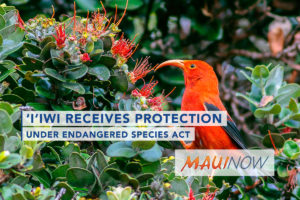‘I‘iwi Receives Protection Under Endangered Species Act
The ‘i‘iwi, also known as the scarlet honeycreeper, will be protected as a threatened species under the Endangered Species Act, the US Fish and Wildlife Service announced.

This nectar feeding member of the honeycreeper family, with its brilliant scarlet body plumage and black wings and tail, abounds in the forest canopy where ‘ōhi‘a lehua blossoms are plentiful. The ‘i‘iwi’s long, down curved, orange bill is specialized for sipping nectar from tubular flowers. The ‘i‘iwi’s “squeaky hinge” call can be heard throughout the forest when the birds are present. PC: USFWS-Pacific Region
Once one of the most common forest birds in the Hawaiian Islands, officials say that ‘i‘iwi are now virtually gone from the islands of Lāna‘i, O‘ahu, Moloka‘i and West Maui, while the population on Kaua‘i is in steep decline.
The FWS said that 90% of the current population is confined to a narrow band of forest on East Maui and the windward slopes of the island of Hawai‘i, between 4,265 and 6,234 feet in elevation.
The FWS determined that listing was warranted based on a review of the best information available for the ‘i‘iwi, gained through exhaustive research, public comments and independent scientific peer reviews.
“In recent years, the ‘i‘iwi population has been in sharp decline, due to threats from habitat loss, invasive species and avian diseases, particularly avian malaria,” said Mary Abrams, project leader for the Service’s Pacific Islands Fish and Wildlife Office. “These threats have affected all forest birds, not just the ‘i‘iwi. Conservation that benefits the ‘i‘iwi will undoubtedly benefit other Hawaiian forest birds.”
Officials say that avian malaria, carried by invasive mosquitos, is the primary driver in the decline in of the ‘i‘iwi population, and has already caused the decimation of dozens of other Hawaiian forest birds. The disease kills approximately 95% of infected ‘i‘iwi. Mosquitos, which are not native to the Hawaiian Islands, breed and thrive at lower and warmer elevations where they infect birds like the ‘i’iwi with avian malaria and pox.
“‘I‘iwi have virtually disappeared from any habitat where mosquitoes are found,” said Abrams. “This has caused their range to shrink dramatically – they are almost entirely limited to higher elevation ‘ōhi‘a forests for their habitat, dietary, and nesting needs.”
Higher and cooler elevation ‘ōhi‘a forests, where mosquitoes do not thrive, remain the only habitat for the ‘i‘iwi, but the FWS says even those areas are under threat. As temperatures rise, mosquitoes, and the avian diseases they carry, are able to survive at higher elevations and spread upwards into the mountains, further constricting the ‘i‘iwi’s range.
On the island of Hawai‘i, home to 90% of the remaining ‘i‘iwi population, those ‘ōhi‘a forests have been under attack from rapid ‘ōhi‘a death, an invasive tree pathogen.
“Working with the state, our conservation partners and the public will be crucial as we work to recover the ‘i‘iwi, said Abrams. “The Service is committed to building on our record of collaborative conservation to protect Hawaii’s native species.”
The Service’s final listing rule will be published in the Federal Register on Sept 20, 2017, and will become effective on Sept 20, 2017. Next steps include development of a recovery plan, which will be bolstered by input from other federal and state agencies, other conservation partners and the public.
More information, including the final listing, can be found here.





_1665772378545.webp)



